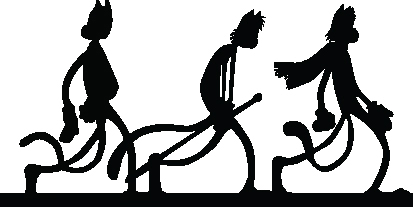In The Hero with a Thousand Faces (1949), Joseph Campbell sums up his elaborate deconstruction of the hero’s journey - what he deemed “monomyth” for its supposed universal application - as a narrative structure in which: “A hero ventures forth from the world of common day into a region of supernatural wonder: fabulous forces are there encountered and a decisive victory is won: the hero comes back from this mysterious adventure with the power to bestow boons on his fellow man.” Based on Carl Jung’s archetypal theories of the collective unconscious, which in turn were influenced by The Tibetan Book of the Dead and its stages of re-birth, or “self-liberation”, Campbell’s monomyth paradigm continues to serve as the ultimate roadmap for effective storytelling. Considered evident in everything from Beowolf to Star Wars, this “epic” model with its traditionally male protagonist-hero, perhaps has its greatest impact in the realm of comic books. Here, arguably, it also finds its most impressionable audience: boys.
In the work of artist Tom Bolger, who, like many pubescent males, grew up obsessed with comics featuring outsiders and outcasts triumphing against all odds, this impact becomes the journey itself, a tale of pathos and redemption in which the concept of the hero’s journey is turned on its head. Through the evolution of more complex associations - the artist’s critical interest in the writings of Homer, D.W. Winnicott, and Satre, for example - Bolger began to conceive of a counter-narrative in which three brothers who struggled blindly for thousands of years in a search for the unattainable, “loving only what they can’t have”, are at last on their way home.
The results of these influences are a series of large-scale ink drawings that deliberately contrast the crudely rendered characters in the foreground with laboriously detailed backgrounds where fine lines accumulate and reveal the kind of variegated nuance of 16th century Flemish allegorical drawings as well as the flattened perspective of 18th century Japanese woodblock prints. Sentient remnants of a post-apocalyptic world, the three brothers are conceived by Bolger as a composite figure, a psychic representation of a fractured whole. There is the emotionally injured self, represented by the eldest brother who wears a sling, the hopeless romantic vainly festooned in scarves, and the fearful aggressor brandishing his sword.
As important as the characters are, the context of their world is equally significant in Bolger’s conception. For while once upon a time these brothers were masters of all they surveyed, their story begins after they’ve wandered for millennia in a wasteland littered with broken signposts of power. In fact, they move back in time rather than forward, such that the modern world of their destruction is soon replaced by the warped ruins of ancient civilizations (Greco-Roman, Amerindian, etc.). Finding thematic synergy between Roman warriors conquering the Gauls and the relationship between Batman and Robin, or the Tibetan guardian figures and the early works of Walt Disney , Bolger’s mashup of historical and cultural allusions serves to underscore the ubiquitous nature of the monomyth, collapsing references along with the panaceas they represent. More evocatively, it conjures the buried loss and grief of a boyhood mired in loneliness and impossible dreams. Perhaps this is the meaning of the torch, variously held by the three brothers, which illuminates not just the decadent scenes of crumbling cityscapes and fallen monuments, but the failure conceded therein. In this fundamental way Bolger re-writes the script. His is a story of the hero’s journey told in reverse. No victory, no power is bestowed in the end, just the illumination of the human condition: fragile, full of impermanence, and best powered by a seeking within.
-Jane Harris 2013
